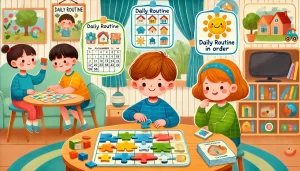Providing educational activities at home is a fantastic way to engage children in learning, but one challenge parents and educators face is adapting these activities to different age groups. A three-year-old and an eight-year-old, for example, have very different levels of comprehension, motor skills, and attention spans. However, with a little creativity and flexibility, you can design activities that suit multiple age ranges while keeping learning fun and effective.
This article will guide you on how to adapt educational activities for different age groups, ensuring that learning at home is both meaningful and enjoyable.
Understanding Developmental Differences
Before adapting activities, it’s essential to understand the different developmental stages of children. Here’s a general breakdown:
- Toddlers (1-3 years old) – Developing basic motor skills, sensory exploration, and simple problem-solving.
- Preschoolers (3-5 years old) – Learning through play, improving fine motor skills, recognizing letters and numbers, and beginning logical thinking.
- Early Elementary (6-8 years old) – Developing reading, writing, and math skills, understanding cause and effect, and improving concentration.
- Older Elementary (9-12 years old) – Enhancing critical thinking, independent learning, and more structured academic skills.
Now, let’s explore ways to adapt activities for each age range.
Storytelling and Reading Activities
Activity: Reading a Story Together
How to Adapt:
- Toddlers (1-3 years old): Use board books with bright pictures, engage them by pointing to objects and making animal sounds.
- Preschoolers (3-5 years old): Read interactive books, ask them to predict what happens next, and encourage them to retell parts of the story.
- Early Elementary (6-8 years old): Introduce longer storybooks, ask comprehension questions, and let them act out scenes.
- Older Elementary (9-12 years old): Encourage independent reading, discuss themes and characters, and have them write a short summary or alternative ending.
Arts and Crafts
Activity: Creating a Nature Collage
How to Adapt:
- Toddlers: Let them explore different textures (leaves, sand, cotton) and help them glue pieces onto paper.
- Preschoolers: Allow them to cut out shapes, glue objects, and explain what they are creating.
- Early Elementary: Introduce a theme (e.g., seasons or animals), encourage them to design their own layout, and discuss their choices.
- Older Elementary: Challenge them to make a detailed nature-inspired painting or sculpture and explain their creative process.
Math Games
Activity: Counting and Number Recognition
How to Adapt:
- Toddlers: Use large, colorful objects to count together, like blocks or fruit.
- Preschoolers: Play simple counting games using toys or fingers, introducing number puzzles.
- Early Elementary: Practice basic addition and subtraction with real-world applications, like counting snacks or measuring ingredients.
- Older Elementary: Introduce multiplication and division through games like store role-play, where they “buy” and “sell” items with pretend money.
Science Exploration
Activity: Simple Baking Soda and Vinegar Volcano
How to Adapt:
- Toddlers: Let them observe the reaction and describe what they see.
- Preschoolers: Encourage them to predict what will happen before mixing ingredients.
- Early Elementary: Teach them about chemical reactions and ask them to experiment with different amounts.
- Older Elementary: Have them write a hypothesis, conduct the experiment in multiple ways, and record results in a science journal.
Physical Activities
Activity: Obstacle Course
How to Adapt:
- Toddlers: Keep it simple with crawling through tunnels, stepping over pillows, and jumping in place.
- Preschoolers: Add tasks like hopping on one foot or tossing a ball into a basket.
- Early Elementary: Increase the difficulty with timed challenges and teamwork elements.
- Older Elementary: Turn it into a competitive race or introduce elements like balancing a book on their head while walking.
Music and Rhythm
Activity: Singing and Dancing to Music
How to Adapt:
- Toddlers: Play simple songs with repetitive lyrics and encourage them to clap or dance.
- Preschoolers: Teach them simple action songs and encourage them to mimic dance moves.
- Early Elementary: Introduce rhythm games with clapping patterns or simple instruments.
- Older Elementary: Have them create their own lyrics or choreograph a short dance routine.
Problem-Solving and Critical Thinking
Activity: Building with Blocks or LEGO
How to Adapt:
- Toddlers: Let them explore stacking and knocking down blocks.
- Preschoolers: Encourage them to build simple structures, like a tower or a bridge.
- Early Elementary: Challenge them to follow picture-based instructions and build specific shapes.
- Older Elementary: Introduce engineering challenges, such as building a bridge that can hold weight.
Writing and Creative Expression
Activity: Writing a Short Story
How to Adapt:
- Toddlers: Let them draw pictures while you tell a story aloud.
- Preschoolers: Encourage them to dictate a story while you write it down and illustrate it together.
- Early Elementary: Have them write simple sentences or comic strips.
- Older Elementary: Encourage them to write a full short story with characters, plot, and conflict.
Final Thoughts
Adapting educational activities for different ages ensures that children of all developmental levels can engage in learning at home. By making small modifications to activities, you create an inclusive and enriching environment where siblings or groups of children can learn together.
Remember, the key to successful home education is flexibility and creativity. Observe how each child responds to an activity and adjust it as needed. By doing so, you’ll foster a love of learning that grows with them through the years.




